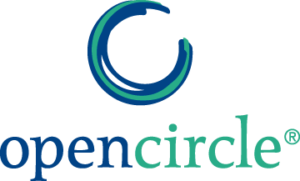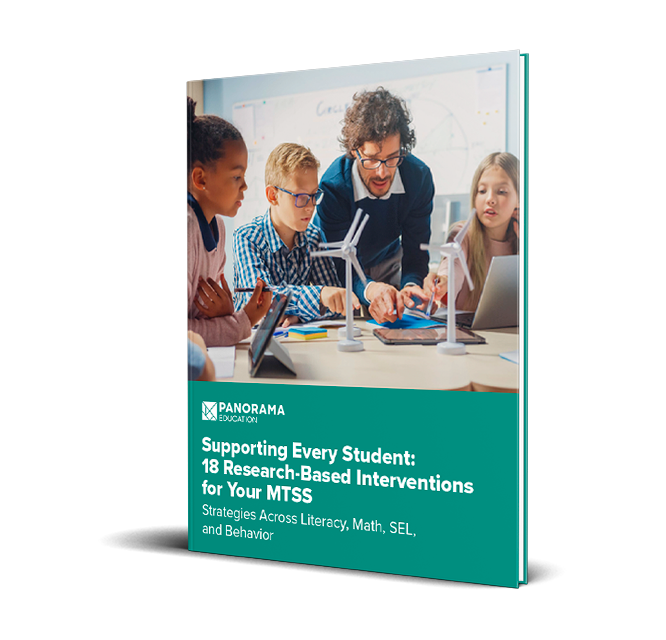Teachers often know when students need more support, but struggle to find the right interventions to meet the need. They devote precious hours to poring over binders packed with strategies, searching for an effective intervention or activity for their specific circumstances. And when they find one, they may be unsure if it’s grounded in research or approved by their district.
Imagine a robust and flexible digital professional learning library that connects educators with hundreds of instructional resources, life skills activities, academic interventions, behavior management strategies—all designed to help educators support students holistically.
At Panorama, we imagined—and curated–that learning library available for all partner schools and districts who use our platform. We’ve updated Panorama’s Playbook with 200+ new strategies, including brand-new categories for behavior and academic interventions to support your entire MTSS program at the elementary and secondary levels. Former district administrators and classroom teachers at Panorama, together with leading researchers and subject-matter experts, created the strategies.
Educators can move from the understanding gained through Panorama data to taking action by filtering Playbook strategies by domain, tier, topic, rating, developmental stage, framework, and several other categories to quickly find best practices to meet their students' needs. They can save relevant strategies, to easily access them again.
We’re sharing a sneak peek at the new strategies we’ve added to Playbook by publishing five of our favorites below.
Download the full toolkit of 18 MTSS interventions.
5 New Interventions That Integrate Academics and Life Skills
Try these five interventions that integrate academics and life skills. See Playbook for additional intervention details, including more implementation tips and differentiation best practices.
- Growth Mindset Statements
- Story Mapping
- Math Journal
- Generating Questions
- Question-Answer Relationship (QARs) - Math Graphics
1. Growth Mindset Statements
Growth Mindset Statements are statements that aim at motivating students to develop to their best potential by reflecting on and working on their abilities. This strategy strives to shift a student’s mindset from a fixed one (where abilities are considered innate) to a growth mindset (where abilities can be acquired and improved through effort and study). This outlook creates a positive approach toward the learning process and builds the resilience students need to manage setbacks in learning.
- Focus Areas: Phonemic Awareness, Comprehension, Fluency, Growth Mindset, Phonics, Vocabulary, Writing
- MTSS Tiers: Tier 1, Tier 2, Tier 3
- Developmental Stages: Lower Elementary, Upper Elementary, Middle School, High School
- Goal: The goal of the strategy is to motivate students to learn, empower students by helping them identify and improve their abilities, and help students reflect on their abilities to understand that setbacks are disguised opportunities for learning.
Action:
Preparation:
- Explore the difference between a fixed mindset and a growth mindset:
- Students with a fixed mindset assume that talent and intelligence are inborn. Because of this, they may think that they cannot improve, so they resist learning.
- Students with a growth mindset believe that they can develop their skills through practice and challenging work. They are also receptive to feedback as they believe it helps them improve their performance.
- Reflect on how encouragement and feedback can foster a grade-appropriate growth mindset in students in various learning situations. Fostering a growth mindset requires intentional effort and can be integrated into everyday classroom practice.
Instructions:
- As students work independently in a classroom situation, provide statements that can encourage a growth mindset.
- Avoid praising intelligence:
- *Avoid: You are so smart!
- Use: Your study plan helped you a lot. Do make another one for the next test.
- Remind students that mistakes are part of the learning process. Point out examples of your own mistakes and share steps you took to correct your mistakes.
- Teach students to overcome challenges in learning. Portray difficult tasks as fun and exciting.
- Promote cooperative learning. Explain that working together develops team spirit and enhances the possibility of finding solutions to challenges.
- Motivate students to expand their thinking during discussions by encouraging them to process the content in detail.
- Encourage students to share their goals in a journal and hold periodic discussions with them on their progress in meeting these goals. Ensure them that their goals can be met in small steps, achievable by the end of the grade.
- Promote positive language as a tool to guide students to speak about their own learning.
When You Might Use This Strategy:
- The Growth Mindset strategy can be an ongoing activity used throughout school, in all classes, to help students develop a positive attitude about their learning and realize their fullest potential.
- The strategy is especially helpful for students experiencing learning challenges or who are behind in their studies.
Why this works:
This strategy helps motivate students to view their abilities as a work-in-progress through reflection and improvement. Through several classroom practices and appropriate use of language, it encourages students to strive to meet their fullest potential and to create a positive attitude toward the learning process.
Supporting Evidence:
Dweck, Carol S., Ph.D. Mindset: The New Psychology of Success. New York, NY: Ballantine Books, 2007.
2. Story Mapping
Story Mapping is a strategy where students create a graphic organizer to visualize the elements and structure of a story. It helps students understand the text on a structural level, which builds literary analysis and writing skills. It is applicable as an individual or group exercise, and is equally effective as a learning strategy, as well as an assessment tool.
- Focus Areas: Comprehension, Writing
- MTSS Tiers: Tier 1, Tier 2, Tier 3
- Developmental Stages: Lower Elementary, Upper Elementary, Middle School, High School
- Goal: The Story Mapping strategy is meant to equip students with a reliable method of identifying the key elements of a story and their connections to each other.
Action:
Story maps can have a variety of looks and layouts, depending on the level of your students. At higher grades, maps might include the story exposition, conflict, rising action, climax, falling action, and resolution. Lower grades might simply include the setting, characters, and events in the beginning, middle, and end of the story.
Preparation:
- Prepare a blank story map for each student.
- In order to use the story map, students must be familiar with the elements of a story: character, plot, setting, and theme.
- The terminology for various story elements may be scaffolded, or adapted for younger grades, such as:
- Character, Setting, Actions, Problem, Solution
- Character, Setting, Events, Ideas
- Who, Where, What happens, Why
Instructions:
- Remind students of the elements of a story.
- Provide students with a blank story map template to fill in.
- Model the construction of a story map graphic organizer for a commonly-known story.
- As students read a new story, have them stop periodically to fill in parts of the story map.
- Give students time to compare their story maps and make necessary changes as they read.
Implementation Tips:
- Review the concept of each story element before having students fill in their own story maps.
- Reintroduce the concept of a story map as you make the maps more sophisticated throughout the school year.
- If students are reading a story in more than one sitting, have them refer back to their story maps in progress.
Why this works:
This strategy can be used as early as first grade and is applicable at all levels of education. It builds the crucial academic skill of visually organizing information, which is used in nearly all fields of study. It engages with visual learners (and possibly tactile learners, depending on implementation) and develops independent metacognitive engagement with the story. It encourages collaboration and creativity and gives students a sense of ownership in their learning.
Supporting Evidence:
3. Math Journal
Math Journals are a collection of thoughts, explanations, and illustrations that show evidence of a student’s learning. Journals give students practice at putting their knowledge into words and communicating mathematically. Math Journals are shared with the teacher, furthering communication between teacher and student, and give teachers insight on a student’s understanding of a topic or skill. They can also provide a platform for students to share any concerns or problems they may be having that interfere with learning the material.
- Focus Areas: Computation, Comprehension, Problem-Solving
- MTSS Tiers: Tier 1, Tier 2, Tier 3
- Developmental Stages: Upper Elementary, Middle School, High School
- Goal: Math Journals help students develop their own thought process as they explain their understanding of math concepts and problem-solving strategies. Journals also allow teachers to identify misconceptions, strengths, weaknesses, and student progress.
Action:
Students may use their Math Journals to take notes on important ideas, definitions, and formulas; solve problems; illustrate ideas; explain their thinking; and reflect on their learning.
Preparation:
- Materials needed, journals and writing utensils for students
- Consider the lesson objectives and the types of questions you want to ask students. Suggested areas of focus:
- Access prior knowledge
- Definitions and math concepts
- Attitudes toward a concept
- Visual representations such as models, diagrams, and drawings
- Additional problems
- Problem-solving strategies
- Written explanations
Instructions:
- Assign a writing prompt or problem.
- Allow time for students to complete the task. Walk around the classroom to answer questions and provide guidance.
- Allow students to share their work in pairs or with the class. Encourage students to use mathematical vocabulary.
- Collect journals to evaluate methods, mathematical reasoning, and solutions.
- Give feedback.
When You Might Use This Strategy:
- Use Math Journals to build the confidence of shy, quiet learners.
- Math Journals can be used as formative assessments to monitor the progress of learning
- Journaling can be done daily, weekly, or at the end of a topic.
Implementation Tips:
- When you first introduce Math Journals, model journal entries for the class to give students an example of what is expected of them.
- To familiarize students with the writing process, have students answer questions verbally first before writing in their journals.
Why this works:
Math Journals give students opportunities to clarify their understanding of math concepts and explain their reasoning that otherwise may not be possible during classroom instruction. Journal entries are a way that teachers can monitor student understanding. They can provide a communication pathway for students who may be reluctant to participate orally in class.
Supporting Evidence:
Baxter, J. A., Woodward, J., & Olson, D. (2005). Writing in mathematics: An alternative form of communication for academically low-achieving students. Learning Disabilities Research & Practice, 20(2), 119–135.
4. Generating Questions
Generating Questions is a strategy that gives the reading experience purpose. It helps students engage with the text. It also helps students self-monitor comprehension.
- Focus Areas: Comprehension
- MTSS Tiers: Tier 1, Tier 2, Tier 3
- Developmental Stages: Lower Elementary, Upper Elementary
- Goal: The goal of this strategy is to enrich the reading experience by having students ask questions before, during, and after reading to help them clarify, revise, and extend their understanding of a text.
Action:
Preparation:
- Select a reading passage that will be challenging for most students.
- Prepare a two-column questioning chart as described.
Instructions:
- Explain that reading is not a passive activity. To understand and think about a text, readers must engage with the text. One way to engage with a text is to ask questions. Some questions may be answered by the text and help a reader clarify comprehension. Some questions may require inferring, concluding, or evaluating. To answer these types of questions, readers combine text details with prior knowledge and experiences.
- Model the strategy: Display question prompts as follows in a two-column chart: Comprehension column: Who? What? Where? When?; Thinking column: Why? How?
- Provide students with a passage to read that will be challenging for most of them.
- Point out that before students do any thinking about the passage, they should clarify their understanding.
- Ask four volunteers to provide questions for the Comprehension column of the chart: Who? What? Where? When? Record their questions.
- Then, lead the class to revisit the text and provide answers to the questions.
- Point out that now that students have clarified their understanding of the text, it’s time to do some thinking about the ideas in the text.
- Ask two volunteers to provide questions for the Thinking column of the chart: Why? How? Record their questions.
- Lead students to combine text details with prior knowledge and experiences to answer the two thinking questions.
- Guided practice: Guide students in performing the strategy in small groups or in pairs. Provide each team with another reading passage and a questioning chart. Monitor student progress. During this time, scaffold the learning and support students who need assistance in using the strategy. These students may focus on the Comprehension column and ask more than one question per prompt.
- Independent practice: After guided practice and demonstration of mastery, students should use the strategy independently during reading assignments. Students can also be given the opportunity to reflect on the value of generating questions in relation to reading comprehension.
Why this works:
Generating questions has many benefits for readers. The strategy provides a purpose for reading, it allows readers to monitor comprehension at a literal level, and it spurs readers to engage with text at a critical level as well.
5. Question-Answer Relationship (QARs) - Math Graphics
Students can use QARs to help recognize how to interpret math graphics. QARs require students to determine whether the answer to the question is found directly from reading a graphic, through a search of the graphic to make a connection between parts, through an interpretation made based on the graphic, or without use of the graphic. The use of QARs helps to develop graphic interpretation and reasoning skills. It promotes confidence in the problem-solving process.
- Focus Areas: Problem-Solving
- MTSS Tiers: Tier 1, Tier 2
- Developmental Stages: Lower Elementary, Upper Elementary, Middle School, High School
- Goal: The use of QARs with math graphics helps students determine how the graphic can help answer a question. Students will be able to interpret language to decide whether a graphic can be used directly or indirectly to answer a question.
Action:
Preparation:
- Ensure students can differentiate among graphic types.
- Ensure students can read graphics and relay data displayed in graphics.
- Create a set of four data questions and answers relating to a graphic, one that matches each of the four QARs.
- Create a worksheet of problems that include graphics.
Instructions:
- Have students work in small groups. Give each group the question/answer sets.
- Ask groups to identify the QAR associated with each question/answer. Groups should include reasoning for their choices.
- Discuss as a whole class the findings of the activity.
- Provide each student with a worksheet of graphic problems. Have students work individually to choose the appropriate QAR for each question.
- Discuss as a class the findings from the QAR determinations.
- Have students use the appropriate QAR to answer the questions.
When You Might Use This Strategy:
QARs can be used with any math problems that include graphics.
Implementation Tips:
- Students may not recognize the difference between a question asking directly for data and one asking for an interpretation of data. A discussion of typical math vocabulary used to distinguish these is ideal.
- Listing the vocabulary words and which QAR they generally show up in could be a useful tool in the classroom.
Why this works:
Students begin to recognize different ways that graphics can be used to help answer math problems. They develop a sense for the types of questions that require computation or analysis from a graphic versus those that can be answered directly from data. This helps students develop reasoning skills.
Supporting Evidence:
Mesmer, H. A. E., & Hutchins, E. J. (2002). Using QARs with charts and graphs. The Reading Teacher, 56, 21-27.
Raphael, T. (1982). Question-answering strategies for children. The Reading Teacher, 36, 186-190.
Move from Understanding Student Need to Intervention and Support
Districts who partner with Panorama can move seamlessly from reviewing student data to pinpointing life skills, climate, and behavior strategies aligned to school survey topics or other data sources.
No more frustrating afternoons trying to remember which binder contains the strategy that might make sense to use. With Playbook, teachers can spend less time looking for the right intervention and more time focused on implementing proven strategies to holistically support students.



.png)



